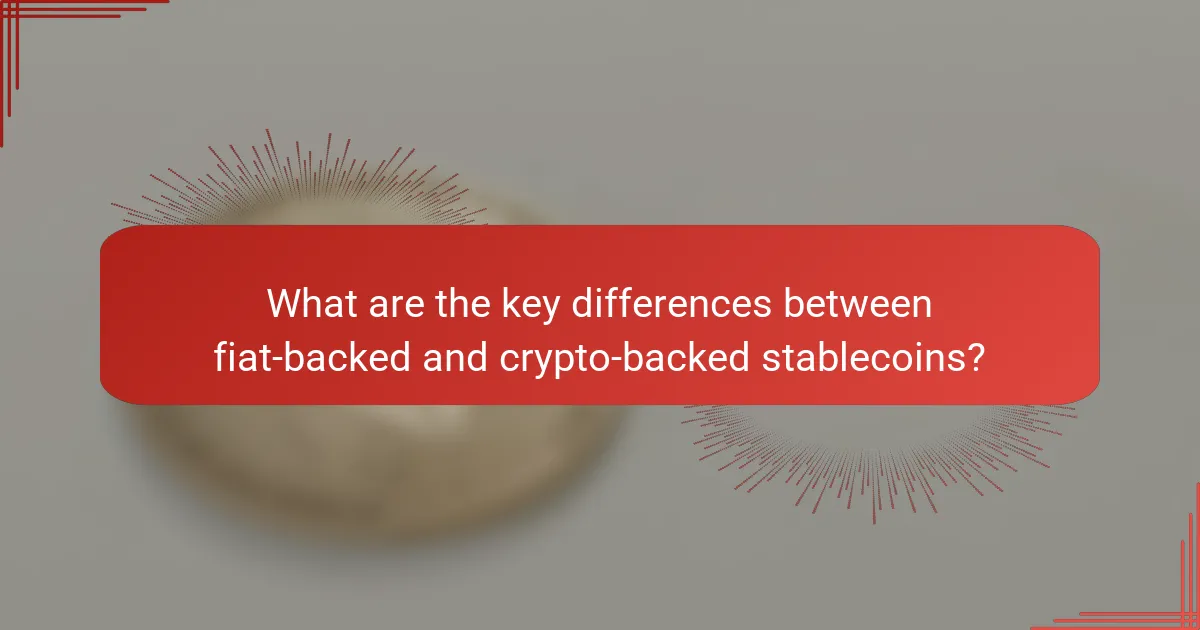Fiat-backed stablecoins are directly linked to traditional currencies, providing stability through reserves of fiat, such as the US dollar. In contrast, crypto-backed stablecoins utilize cryptocurrencies as collateral, relying on smart contracts to maintain their value. Understanding these key differences is essential for investors aiming to navigate the evolving stablecoin landscape effectively.

What are the key differences between fiat-backed and crypto-backed stablecoins?
Fiat-backed stablecoins are directly tied to traditional currencies, while crypto-backed stablecoins use cryptocurrencies as collateral. Understanding these differences is crucial for investors looking to navigate the stablecoin market effectively.
Fiat-backed stablecoins are pegged to traditional currencies
Fiat-backed stablecoins maintain a fixed value by being pegged to a specific fiat currency, such as the US Dollar or Euro. For example, one US Dollar-backed stablecoin is typically worth one US Dollar. This peg is often supported by reserves held in traditional banking systems, ensuring stability and liquidity.
Investors can benefit from the predictability of fiat-backed stablecoins, especially in volatile markets. However, they should be aware of the regulatory implications and the need for transparency regarding the reserves backing these coins.
Crypto-backed stablecoins are collateralized by cryptocurrencies
Crypto-backed stablecoins derive their value from other cryptocurrencies, which serve as collateral. For instance, a stablecoin might be backed by Ethereum or Bitcoin, with a collateralization ratio that ensures the stablecoin remains stable even if the underlying asset fluctuates in value. This often involves over-collateralization to mitigate risks.
While crypto-backed stablecoins can offer higher potential returns, they also come with increased volatility and risk. Investors should carefully assess the collateralization ratios and the mechanisms in place to maintain stability during market downturns.
Regulatory frameworks differ significantly
The regulatory landscape for fiat-backed and crypto-backed stablecoins varies widely. Fiat-backed stablecoins often face stricter regulations due to their ties to traditional financial systems, requiring compliance with anti-money laundering (AML) and know your customer (KYC) regulations.
In contrast, crypto-backed stablecoins may operate in a more decentralized manner, but they still face scrutiny from regulators concerned about market manipulation and consumer protection. Investors should stay informed about the evolving regulations in their jurisdictions to navigate potential legal risks.
Market stability varies between types
Fiat-backed stablecoins generally offer greater market stability due to their direct connection to established currencies. This stability makes them a popular choice for traders and investors seeking to hedge against volatility in the cryptocurrency market.
On the other hand, crypto-backed stablecoins can experience fluctuations based on the performance of the underlying assets. Investors should consider their risk tolerance and investment strategy when choosing between these two types of stablecoins, as market conditions can significantly impact their value.

How do fiat-backed stablecoins work?
Fiat-backed stablecoins are cryptocurrencies that maintain a stable value by being pegged to a fiat currency, such as the US dollar. Each stablecoin is typically backed by an equivalent amount of fiat currency held in reserve, ensuring that it can be redeemed at a consistent value.
Examples include Tether (USDT) and USD Coin (USDC)
Two prominent examples of fiat-backed stablecoins are Tether (USDT) and USD Coin (USDC). Tether is widely used in trading and has a significant market presence, while USD Coin is known for its transparency and regulatory compliance. Both aim to provide stability in the volatile cryptocurrency market.
Backed by reserves held in traditional banks
Fiat-backed stablecoins are supported by reserves that are typically held in traditional banks or financial institutions. This backing ensures that for every stablecoin issued, there is an equivalent amount of fiat currency securely stored. Regular audits are often conducted to verify these reserves, enhancing trust among users.
Facilitates easy conversion to fiat currency
One of the key advantages of fiat-backed stablecoins is their ability to facilitate easy conversion to fiat currency. Users can quickly exchange stablecoins for cash or bank deposits, making them a practical tool for both trading and everyday transactions. This liquidity is crucial for investors looking to move in and out of cryptocurrency markets efficiently.

How do crypto-backed stablecoins work?
Crypto-backed stablecoins are digital currencies that maintain their value by being pegged to other cryptocurrencies rather than traditional fiat currencies. They achieve stability through collateralization and smart contracts, which help manage the supply and demand dynamics in the market.
Examples include DAI and sUSD
DAI and sUSD are prominent examples of crypto-backed stablecoins. DAI is pegged to the US dollar and is generated through the MakerDAO system, where users lock up Ethereum as collateral. sUSD, part of the Synthetix platform, allows users to create synthetic assets that mimic the value of fiat currencies or commodities.
Collateralized by other cryptocurrencies
Crypto-backed stablecoins are typically collateralized by other cryptocurrencies, which means they are secured by assets like Ethereum or Bitcoin. This collateralization helps maintain the stablecoin’s value, as the locked assets can be liquidated if the value of the stablecoin drops significantly. Generally, the collateralization ratio is set above 100% to provide a buffer against market volatility.
Utilizes smart contracts for stability
Smart contracts play a crucial role in the operation of crypto-backed stablecoins by automating the processes of collateral management and liquidation. These self-executing contracts ensure that the system remains stable by adjusting the supply of the stablecoin based on market conditions. Users should be aware that while smart contracts enhance security and efficiency, they also introduce risks related to coding errors and vulnerabilities.

What are the advantages of fiat-backed stablecoins?
Fiat-backed stablecoins offer several advantages, primarily rooted in their stability and regulatory compliance. These digital currencies are pegged to traditional fiat currencies, making them less susceptible to the extreme price fluctuations often seen in cryptocurrencies.
Higher liquidity in traditional markets
Fiat-backed stablecoins typically enjoy higher liquidity compared to their crypto-backed counterparts. This is largely due to their direct ties to established fiat currencies like the US Dollar or Euro, which are widely accepted and traded in traditional financial markets.
Investors can easily convert fiat-backed stablecoins into cash or other assets, facilitating smoother transactions. This liquidity is crucial for those looking to enter or exit positions quickly without significant price impacts.
Less volatility compared to crypto-backed options
Fiat-backed stablecoins are generally less volatile than crypto-backed stablecoins, which can be subject to market speculation and fluctuations in the value of the underlying cryptocurrency. The peg to fiat currencies helps maintain a stable value, providing a reliable option for investors seeking to avoid the wild price swings associated with crypto markets.
This stability makes fiat-backed stablecoins an attractive choice for users looking to preserve their capital while still engaging in the digital asset ecosystem. For example, during market downturns, these stablecoins can help investors maintain their purchasing power.
Regulatory compliance enhances trust
Fiat-backed stablecoins often adhere to regulatory standards, which can enhance trust among users and investors. Compliance with financial regulations ensures that these stablecoins are subject to oversight, reducing the risks associated with fraud or mismanagement.
For instance, many fiat-backed stablecoins undergo regular audits to verify their reserves, providing transparency that can reassure users. This regulatory framework can attract institutional investors who prioritize security and compliance in their investment strategies.

What are the advantages of crypto-backed stablecoins?
Crypto-backed stablecoins offer several advantages, including decentralization, potential for higher yields, and flexibility in the types of collateral used. These features make them appealing to investors seeking alternatives to traditional fiat-backed stablecoins.
Decentralization reduces counterparty risk
Decentralization is a key benefit of crypto-backed stablecoins, as it minimizes reliance on a single entity or institution. This reduces counterparty risk, meaning that the risk of loss due to the failure of a central authority is significantly lower.
For example, in a decentralized stablecoin system, assets are often held in smart contracts on a blockchain, which operate autonomously. This structure enhances security and transparency, allowing users to verify the backing of their stablecoins without needing to trust a centralized organization.
Potential for higher yields through staking
Investors in crypto-backed stablecoins can often earn higher yields through staking compared to traditional savings accounts or fiat-backed stablecoins. Staking involves locking up a portion of your assets to support network operations, and in return, you receive rewards.
Yields from staking can vary widely, typically ranging from low single digits to over 10% annually, depending on the specific stablecoin and the underlying blockchain’s performance. This potential for higher returns makes crypto-backed stablecoins attractive for yield-seeking investors.
Flexibility in collateral types
Crypto-backed stablecoins often allow for a diverse range of collateral types, including various cryptocurrencies and tokens. This flexibility enables users to choose assets that align with their investment strategies or risk tolerance.
For instance, some platforms accept popular cryptocurrencies like Bitcoin or Ethereum as collateral, while others may include lesser-known tokens. This variety can enhance liquidity and provide users with more options to manage their investments effectively.

What should investors consider when choosing between stablecoin types?
Investors should evaluate factors such as risk tolerance, market volatility, and the underlying assets of different stablecoin types. Understanding these elements can help in making informed decisions that align with individual investment goals.
Risk tolerance and market volatility
Risk tolerance is a crucial factor when choosing between fiat-backed and crypto-backed stablecoins. Fiat-backed stablecoins, typically pegged to traditional currencies like the USD or EUR, tend to offer more stability and lower volatility. In contrast, crypto-backed stablecoins can experience greater price fluctuations due to the inherent volatility of the cryptocurrencies they are tied to.
Investors with a low risk tolerance may prefer fiat-backed options, as they are generally less susceptible to sudden market changes. On the other hand, those willing to accept higher risks for potentially greater rewards might consider crypto-backed stablecoins, which can offer higher yields but come with increased price instability.
To assess your risk tolerance, consider your investment horizon and financial goals. A common approach is to allocate a portion of your portfolio to stablecoins based on your comfort level with market fluctuations, ensuring a balanced strategy that aligns with your overall investment plan.


